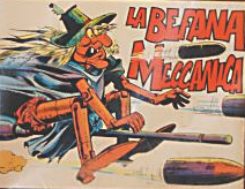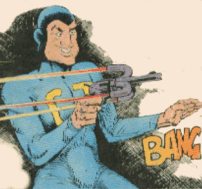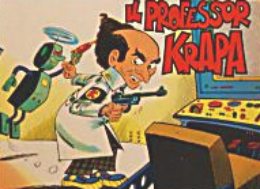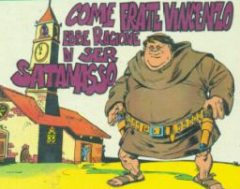JONNY LOGAN

Original title: Johnny Logan
Characters: Jonny Logan (Giovanni Loganetti), the Professor, Ben Talpa (Benito Talponi), Dan Muscolo (Danilo Muscolotti) and the magician Magoz
AuthorRomano Garofalo
Publishers:
Dardo editions | Country: Italy
Year: 1972
Gender: Humorous cartoon
Recommended age: Teenagers aged 13 to 19 |
Jonny Logan is a humorous comic book character, born in 1972 from the imagination of Romano Garofalo and the pencil of Leone Cimpellin.
Jonni Logan is the protagonist of a shabby gang of bounty hunters. Together with the Professor, Ben Talpa, Dan Muscolo, Mago Magoz, he is busy more than anything else to make ends meet in a race for existence that is always quite precarious. This repetitive pattern is, however, the pretext for a satire of costume which, after many years, is always very topical. Evidently things haven't changed that much ...
Appeared in the early seventies, it immediately had great recognition from critics and the public for two characteristics of absolute novelty in the panorama of Italian comics:
- The setting of the stories in Italy, in a period of great xenophilia, in which it was thought that comics "to work" had to be set in the USA.
- The satire of customs aimed at an audience of 13, 14-year-old readers: never before Jonni Logan had a comic aimed at teenagers dealt with "difficult" topics, such as "Italian coup d'état", on a not so imaginary danger in the Italy of those times; “For or against”, on the controversial issue of divorce; "The Mafia does not exist", as politicians of a certain depth were pleasantly asserting on TV; "Tartassa tax agent", on a topic currently rather debated, and we could continue in these quotes because Jonni Logan was, in some ways, more than a comic: from month to month, from release to exit, he represented a cross-section " satirical and pungent "of the Italy of the time and, more generally, a fresco of our vices and our virtues (more than the others ...).
Jonni Logan also landed on TV, in the successful RaiDue series “Supergulp”.
by Romano Garofalo
Some plots, briefly:

1) La Befana Meccanica - N ° 7 January 1973
January 6, a mechanical befana arrives at the CT house. Yes, that's right, a hoax made of screws and bolts has replaced the old dear old woman of the past. Our friends leave home and realize they have been catapulted in 2002, where science and technology have taken over and, in such a society, there is no longer any place for affections and feelings.
Men are eliminated "by law" after the age of 40 because they are unproductive, and the hunt for poets, artists and creatives in general as subversives of the established order has been legalized.
But this new social organization will have two proud and indomitable opponents: the Befana and Santa Claus, the two nice old men who, out of necessity and as a sign of the times, have become two proud antagonists who oppose any society by any means dehumanized and arid.
2) The Return of the Warrior N 37 August 1975
Mickey, a United States marine, returns from Vietnam: throngs of American patriots go to celebrate him on his arrival. All the TVs are ready to immortalize the event of the return of America's most popular veteran, but here's the big disappointment: Mickey, during his imprisonment, was indoctrinated by the Vietcong: first of all he kicks Pluto "because 'his canine and servile loyalty disgusts him ", then begins his fierce protest against the American system. Bewilderment of those who saw in Mickey Mouse the symbol of the average American, good, industrious, patriot and anti-Communist: "Those communists of the Wietcong have ruined it, Minny is desperate" ...
3) The strange clinic of Doctor Squarta Squarta. N ° 33 March 1975
A story about medical malpractice, or rather about good health for payers who, already at the beginning of the story, are carefully hospitalized in rooms with air conditioning, stereo music, hill views, etc., while the borrowers are sent to an elimination tape that, literally , sends them "out of the way".
In Dr. Squarta Squarta's clinic, everything happens, bets between the nurses on who pulls the leather more quickly, diligent funeral directors who take measures to the patient when he is still alive, low-butchery operations that always end with the arrival of Don Trapassa, the priest who gives extreme unction at a step ... of dance.
The situations are obviously extreme in a caricatural key, but the problem of medical malfunction is a problem that appears real.
4) THE Advertising: N ° 46 - May 1975
The story begins with a short history of advertising: from the beginning, "the first advertiser was the snake who induced Eva to buy an apple", up to the present day when a crazy advertiser and speculator induces people to "false needs", like buying a nose ring, all the rage, or
a lion in the flesh: Walking, guard, even paperweights.
In fact, people appear to be the necessary support of the advertiser, it is almost the reverse of the same medal, in a mad rush to the consumption of the most useless things,
in a party game, almost an exchange of roles, in which it is not clear who is more insane in mind.
5) Once upon a time there was a school ...: N ° 32 - February 1975
As the title says, this story makes a history of the school from its origins to the present day, characterized by the usual problems: on the one hand the always somewhat authoritarian and conservative attitude of the teachers and on the other the pupils' attempt to carve out with irony and slightly joking jokes a space of freedom.
But until you get to the fateful 1968,
the breaking year in which the students contest the authority, demonstrate in the square, take over the school spaces.
In short, a great wind of freedom blows between the classrooms and the ministry of education adapts and takes note of the problems of the school and the need for reform.
But then the 69 passes, you get to the 90s, the protesters of the time have integrated, now they have prestigious positions, positions of power and do not contest .. if they themselves.
Meanwhile, the ministry of education continues to take note of school problems and the need for reform.
6) Italian coup d'état ...: N ° 2 August 1972
The 70s were difficult years, from many sides there were rumors of real or alleged coups that, then, on one occasion, also materialized in a clumsy and messy Italian attempt, as Jonny Logan had prophetically sensed in this history in which we find politicians of the first republic, old tools of the past, nostalgic a little stoned, soldiers who love to play war, all then ended up in the patricians ... asylums.
7) The Mafia does not exist ...: N ° 9 March 1973
It seems almost surreal, but in 1973, when this issue of Jonny Logan came out, it was not uncommon to see some politicians show up on TV and claim, candidly, that no Mafia appeared to him and that it was just an invention of newspapers.
The story starts, therefore, from this paradox to arrive, after trying to understand who was Don Ciccio Bracalone, the protagonist of the story also called "piece of the nineties" we do not know why, to affirm in the anti-mafia commission that "the mafia does not exist "and who does not believe it .. lupara takes it, literally because the only one not in line with the official version is eliminated.
8) Tartassa tax agent: N ° 28 - October 1974
The Italians, returning from holidays, suddenly find themselves terrified, terrified, Tartassa, the tax agent: these words would be enough to characterize a story that, in the collective imagination, evokes dark and atavistic fears that have directly to do with how much the Italians have more 'dear, after mom means: your wallet.
To their excuse they certainly have that Tartassa is a sinister character, with sharp teeth, bloodshot eyes and
an insane desire to tax, tax, tax ...
Moreover, he seems to have a certain preference for taxing the poor rather than the rich with whom he has a "respectful and light" hand, and when he tries to tax the wealthiest, according to the now famous motto that will certainly pass from the news to the story "even the rich cry" ends ... in an asylum.
THE FINGER IN THE PIADA
by Graziano Frediani
 Until sixty, fifty, forty years ago (but the countdown could probably continue until today), in Italy, everything that sounded "American" seemed to have an edge. In order to escape the small, depressing daily miseries of our home, every means was good. In this sense, comics - a genuinely popular art, "evasive" by definition - was unsurpassed in offering cheap "American" dreams. And that the heroes fielded were born (and lived) far, far away from Sperlonga or Cavarzere, first of all their names, exotic yes, but often naively simplified - transforming, perhaps, Sam into Sem, Jack in Gek, Jim in Gim - not to make them difficult for less educated readers. The most used, the name that sounded more "American" than any other, namely John, appeared both as it is (think of "Come on John" and "John Arizona"), and in the pet name variant (and here are the various "Johnny Manila "," Johnny Beat "," Johnny the Long-haired "," Johnny Honda "," Johnny Karate "," Johnny Nero "," Johnny Spingarda "), until, to clear the cards on the table, to break the spell, he didn't come, the Johnny without the "acca", the least "American" Johnny of all ... "Jonny Logan".
Until sixty, fifty, forty years ago (but the countdown could probably continue until today), in Italy, everything that sounded "American" seemed to have an edge. In order to escape the small, depressing daily miseries of our home, every means was good. In this sense, comics - a genuinely popular art, "evasive" by definition - was unsurpassed in offering cheap "American" dreams. And that the heroes fielded were born (and lived) far, far away from Sperlonga or Cavarzere, first of all their names, exotic yes, but often naively simplified - transforming, perhaps, Sam into Sem, Jack in Gek, Jim in Gim - not to make them difficult for less educated readers. The most used, the name that sounded more "American" than any other, namely John, appeared both as it is (think of "Come on John" and "John Arizona"), and in the pet name variant (and here are the various "Johnny Manila "," Johnny Beat "," Johnny the Long-haired "," Johnny Honda "," Johnny Karate "," Johnny Nero "," Johnny Spingarda "), until, to clear the cards on the table, to break the spell, he didn't come, the Johnny without the "acca", the least "American" Johnny of all ... "Jonny Logan".
Despite appearances, Jonny Logan is an Italian character, very Italian, and the living demonstration that, behind the cheap dreams, behind the ambitions of a provincial, behind the thousand, melancholy "I wish but I cannot" from which the children are chronically afflicted del Belpaese (also understood in the sense of cheese), all that glitters is not always gold. Because Jonny Logan is not the real name of a stars and stripes hero, but the ungrammatical pseudonym of someone like us: this Giovanni Loganetti, a young man of good hopes, who applies the old national art of getting by with admirable obstinacy. "In an area that is certainly not luxurious, on the outskirts of a large Italian city, the Banda dei CT lives and works", read the short text that he presented to readers no. 1 of the series, published by Editrice Dardo in July 1972. “Who are the CTs? But the bounty hunters, wow! Tough and ruthless men who stubbornly hunt down bandits for money ”, continued, in a slightly more epic tone, the anonymous drafter of that programmatic manifesto. But he immediately corrected himself, mercilessly resizing the identikit of the CT data: "If we have to be honest, our tough guys aren't even very ruthless, and as for money, they don't see much of it." From this point on, the fresco was tinged with an unequivocal light: "At the head of the band there is" the Professor ", so called for a certain degree in we don't know what, obtained in an undefined place, that is to all unknown. The spearhead of the ganga is Jonny ... inventor of inventions that no one would ever dream of inventing except him; then give prestige to the group, Mago Magoz, illusionist and swindler in his spare time, Ben Talpa, 'the protester' (it is said that something is still to be born that goes right) and finally Dan Muscolo, certainly not among the most ready intelligence , but with an easy punch ". It goes without saying that even Ben Talpa and Dan Muscolo are not what they seem, because the names with which they are registered are Benito Talponi and Danilo Muscolotti respectively… Overall, a quartet of nice scoundrels.
As that significant minus "acca" implies, in Jonny Logan's world there is everywhere something wrong. The walls are crumbling, the streets are broken, the pipes dripping, the clothes patched up, the socks smelly, the shoes smashed, the armpits sweaty, the mouths toothless, the beauties withered, the bellies empty (or too full). And the legitimate aspirations of the poor devils continually slam their noses against the tough armor of the modern consumer society, where hypocrisy, selfishness, corruption, pastettes and messes are the absolute masters. Here, everything hangs in the balance, nothing is in order, no mirage keeps its promises. And the only way to survive without being annihilated is to draw the weapon of ridicule, irony, demystifying joke ...
 In the summer of 1972, when the first issue of "Jonny Logan" made its debut on newsstands, Italy was immersed up to its neck in the Years of Lead: red and black subversive groups, bombers piloted by the Secret Services, more or less anonymous kidnappers, mafiosi colluding with the Christian Democratic power make the atmosphere chaotic and disturbing, but offering many juicy pretexts to which he wants to exercise his critical sense and express his indignation even only (so to speak) in a comic book. "Jonny Logan" sees the light thus, the result of the meeting between two talents of comics made in Italy (an already known and appreciated cartoonist, born in Rovigo but Milanese by adoption, Leone Cimpellin, and a promising screenwriter from Rimini at his baptism of fire, Romano Garofalo), united by the love for a bittersweet humor, seasoned with a pinch of healthy madness.
In the summer of 1972, when the first issue of "Jonny Logan" made its debut on newsstands, Italy was immersed up to its neck in the Years of Lead: red and black subversive groups, bombers piloted by the Secret Services, more or less anonymous kidnappers, mafiosi colluding with the Christian Democratic power make the atmosphere chaotic and disturbing, but offering many juicy pretexts to which he wants to exercise his critical sense and express his indignation even only (so to speak) in a comic book. "Jonny Logan" sees the light thus, the result of the meeting between two talents of comics made in Italy (an already known and appreciated cartoonist, born in Rovigo but Milanese by adoption, Leone Cimpellin, and a promising screenwriter from Rimini at his baptism of fire, Romano Garofalo), united by the love for a bittersweet humor, seasoned with a pinch of healthy madness.
Cimpellin, who signs himself Ghilbert, sharpens his pencil, making it more corrosive than it was when, on the pages of the "Corriere dei Piccoli", he illustrated the cheerful adventures of the misunderstood soldier Gibernetta, the irascible centurion Tribunzio, the candid musketeer Gelsomino , the bungling journalist Gigi Bizz, or futuristic friends Gianni and Rob-8. And Garofalo elaborates increasingly lively, acute, demented stories, dividing himself between Milan and his native, beloved Rimini, where he returns often and willingly to recharge his batteries, in the midst of that sea of piade, pine forests and pedal boats, because, these are his words , "A comic cannot express itself from the environment in which it is born, it cannot cut the umbilical cord with its land, with its people, with its events". And from that apparently small world, which however turns out to be a perfect observatory of the large surrounding world, he re-elaborates - in a satirical key, up to the limits of paradox - both minimal episodes of everyday life and important events hit on the front page by the newspapers.
 Seen with hindsight, as Cimpellin himself recalls in the volume edited by Davide Barzi, published by Edizioni If in 2002, which reconstructs his long career, "stripped from the masks of the US settings of other series, Jonny Logan was going to break the boxes on typically Italian habits and customs, and he did it without metaphors, with precise slashes. In one story, Garofalo even had the Pope kidnapped! ”. But in the events of these willing but cialtroneschi Bounty Hunters there is also much more, and you can easily find out for yourself, reading (or rereading) the first two episodes of the series, proposed in this volume. Two miniature comedies, written and drawn more than thirty years ago (even if it doesn't seem like it) with the provocative intention of using comics both to entertain and have fun, and to point the finger at widespread ailments and malpractice, in front of which - the critic Carlo Brusati said it at the time - Jonny Logan stands as “an antidote, in the sense that he is an anti-hero hero. He opposes violence, legalized crime, abuses, excesses, the mafia, his Latin cunning, his ability to know how to get out of the way with the least effort, his common sense, his dynamism of being poor the stimuli of hunger ". A problem that all the previous Johnnys (with the "acca") had certainly never had to face.
Seen with hindsight, as Cimpellin himself recalls in the volume edited by Davide Barzi, published by Edizioni If in 2002, which reconstructs his long career, "stripped from the masks of the US settings of other series, Jonny Logan was going to break the boxes on typically Italian habits and customs, and he did it without metaphors, with precise slashes. In one story, Garofalo even had the Pope kidnapped! ”. But in the events of these willing but cialtroneschi Bounty Hunters there is also much more, and you can easily find out for yourself, reading (or rereading) the first two episodes of the series, proposed in this volume. Two miniature comedies, written and drawn more than thirty years ago (even if it doesn't seem like it) with the provocative intention of using comics both to entertain and have fun, and to point the finger at widespread ailments and malpractice, in front of which - the critic Carlo Brusati said it at the time - Jonny Logan stands as “an antidote, in the sense that he is an anti-hero hero. He opposes violence, legalized crime, abuses, excesses, the mafia, his Latin cunning, his ability to know how to get out of the way with the least effort, his common sense, his dynamism of being poor the stimuli of hunger ". A problem that all the previous Johnnys (with the "acca") had certainly never had to face.
All names, images and registered trademarks are copyright Romano Garofalo and are used here for cognitive and informative purposes.
<< Previous
